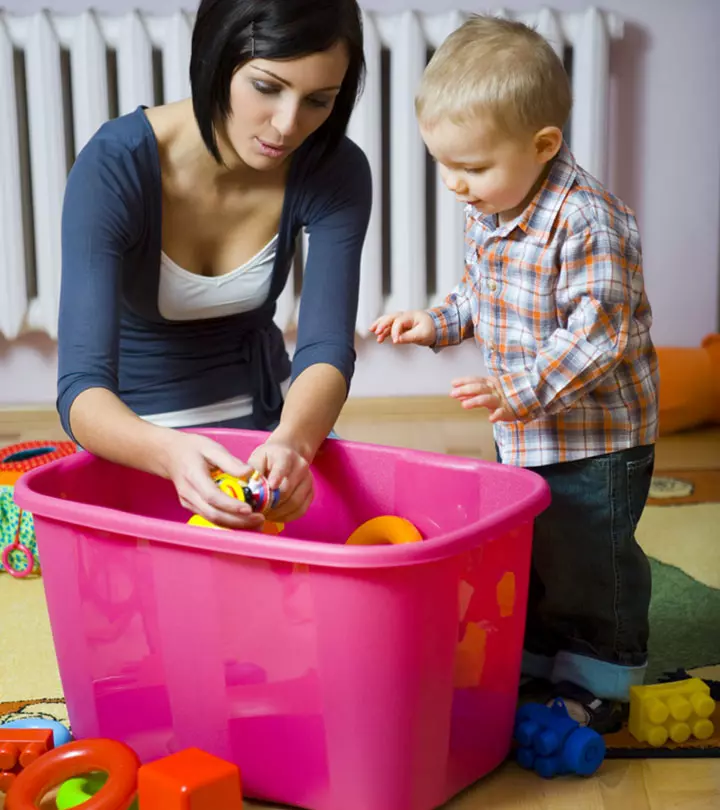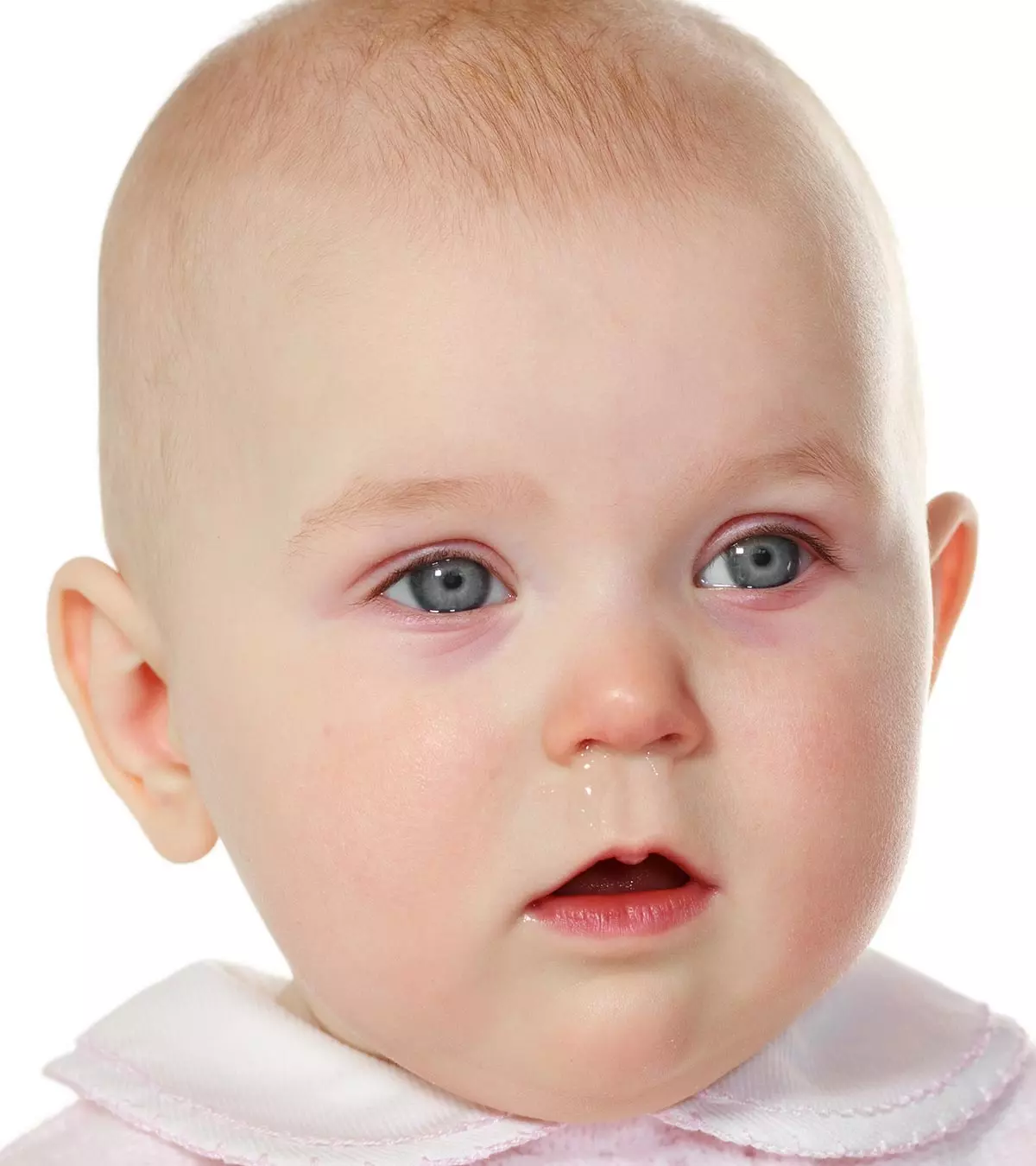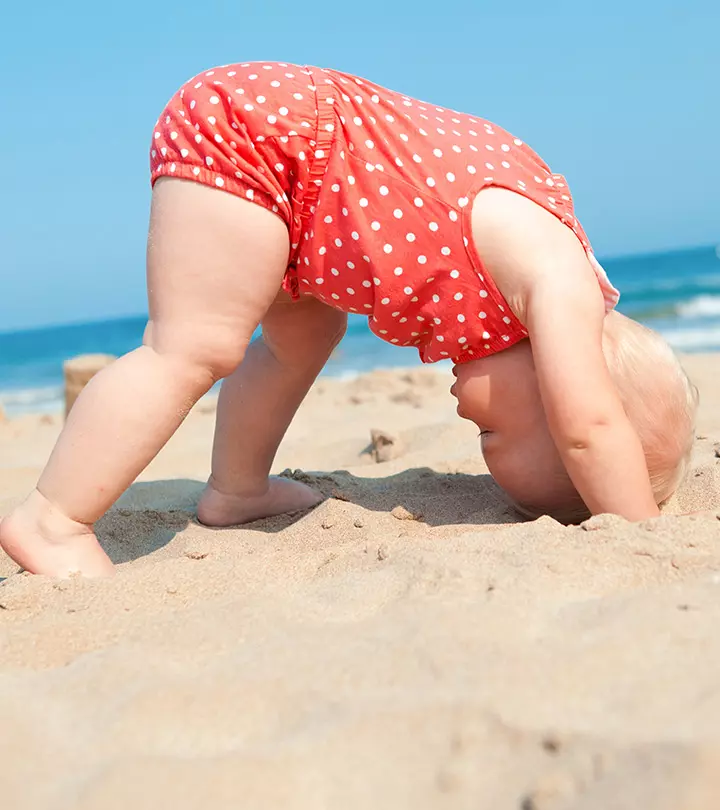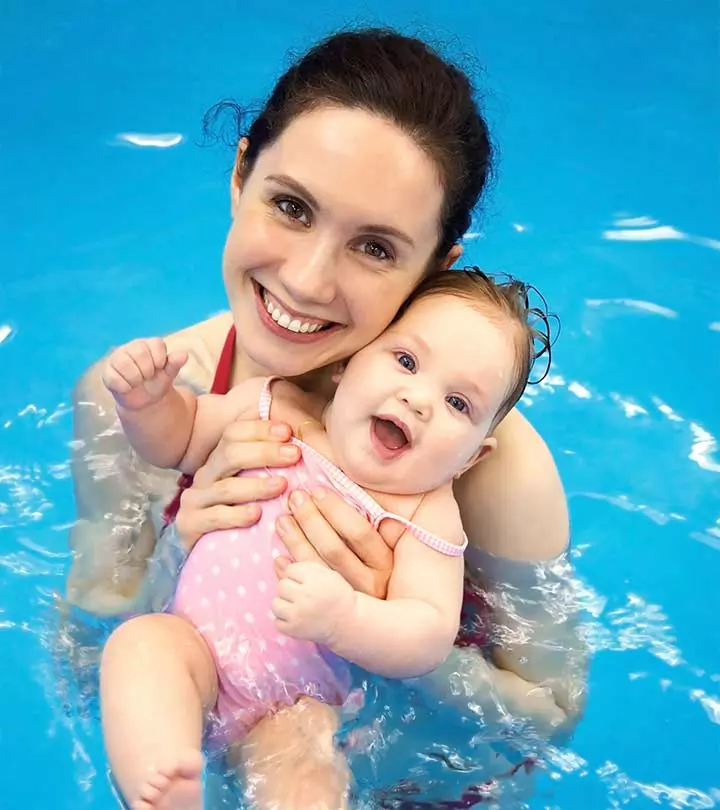
Image: Shutterstock
Watching a baby swimming in a pool with their cute little hands and feet can be a heartwarming experience for parents. However, introducing your baby to swimming at the right age is vital to ensure their safety and enjoyment while in the water. Thus, many parents choose to enroll their babies in formal swimming lessons. The main objective of these classes is to teach babies basic swimming skills that increase their chances of survival in a water emergency. Certified instructors generally conduct these lessons in a pool with the parent or guardian’s presence.
Keep reading to know more about baby swimming, its potential benefits, and effective tips to prepare your baby for swimming.
Key Pointers
- Introduce your baby to the water between six and 12 months after consulting your healthcare provider.
- Use a properly fitting life jacket or floatation device to ensure safety.
- Gradually increase the baby’s exposure to water as they become more comfortable and confident in it.
- Supervise your baby closely at all times while they are in the pool.
Can Infants Swim?

Image: Shutterstock
Infants do not know how to swim from birth. Instead, they need to learn it, just like they would learn to walk. However, they have certain innate reflexes that allow them to perform basic movements resembling swimming strokes (1).
It’s important to note that infant swimming differs from baby swimming.
Infant swimming, also known as survival swimming, typically involves submerging babies under six months in water with the goal of teaching them survival techniques in case of a water emergency. However, this practice is controversial and lacks scientific evidence to support its benefits. Infant swimming may also mostly leverage the innate natural reflexes rather than teaching a new skill, which is the case of teaching babies to swim and float.
 Quick fact
Quick factWhen Can You Take A Baby Swimming?
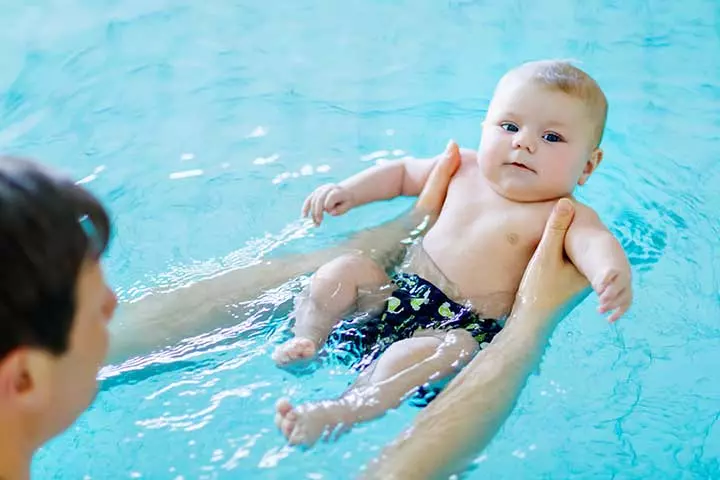
Image: Shutterstock
While babies can be introduced to water from birth, it is not recommended as they can’t regulate their body temperature and are at a higher risk for infections. Thus, most experts recommend waiting until they are at least six months old.
If you want to introduce your baby to the water earlier than six months, ensure the water temperature is warm, around 32℃, to avoid hypothermia. Additionally, avoid taking them to a large public swimming pool as it might increase the risk of infections. The American Academy of Pediatrics (AAP) recommends that formal swimming lessons for babies should begin when they are a year old (3).
 Point to consider
Point to considerHow To Teach A Baby To Swim?
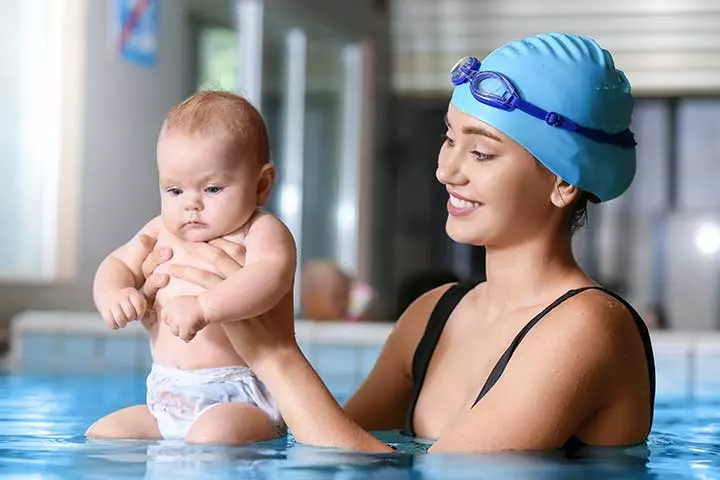
Image: Shutterstock
A trained professional, such as a certified swim instructor specialized in teaching infants and young children, should teach swimming to babies. However, before introducing any swimming techniques, it is essential to start with basic water safety skills. Here are a few points to prepare your baby for swimming.
- Start by familiarizing the baby with the water by placing them in a baby pool or taking them to the shallow end of a pool.
- Use fun and interactive games such as blowing bubbles or splashing to make them feel comfortable in the water.
- Use a flotation device such as a pool noodle, floaties or inflatable ring to support the baby’s weight while they are in the water.
- Use a gentle, calm tone and plenty of encouragement to help the baby feel safe and relaxed in the water.
- Slowly introduce the baby to basic swimming techniques, such as kicking and moving arms, while using the flotation device for support.
- As the baby becomes more comfortable and confident, gradually reduce the use of the flotation device.
Vladimir Anušić, founder of the Baby Swim club in Belgrade, says that teaching swimming becomes easier when you make it an enjoyable activity, “My children have been in the water since the age of four months. That does not mean they had training every day… but that they got relaxed enough to enjoy the water. They learnt how to swim with a smile on their face, while playing in the water and around it (i).”
 Quick tip
Quick tipWhat Are The Benefits Of Teaching Your Baby To Swim?

Image: Shutterstock
Baby swimming may have several benefits for both infants and parents. Some of the key benefits may include (4) (5) (6):
- Physical development: Swimming may help develop babies’ muscles and improve their coordination. It may also help enhance their fitness and stamina. Water is denser than air. Hence, when a baby moves through it, their muscles face resistance, which enhances strength and endurance. The kicking movements strengthen the body’s core, which may help improve coordination between both sides of the body while moving through the water. Practicing other movements in water, such as dancing or throwing objects, may also help develop coordination.
- Sensory development: Being in the water can provide babies with various stimulating experiences, including the sensation of floating, the feeling of water on their skin, and the sensation of movement. It also allows the baby to have one-on-one time with the parent or caregiver, perform repetitive movements, and be exposed to new things, which may aid in the development of their sensory and cognitive abilities in the long run (7).
- Bonding: Swimming with babies can be a fun and bonding experience for parents and babies. While it allows babies to experience being in the water, it can help parents learn about their baby’s abilities and how they interact with their surroundings.
- Confidence and self-esteem building: As babies learn to navigate the water and accomplish new swimming milestones, they may develop a sense of accomplishment and self-confidence in the long run.
- Sound sleep: Swimming may be a great way to tire out babies and help them fall asleep more easily, benefitting their overall health.
- Social development: Formal swimming classes are often done in groups. It allows a chance for babies to interact with other children. This could aid in the development of their social skills and ability to communicate with others.
- Alternative form of exercise for babies with disabilities: Being a non-weight-bearing activity, swimming is considered one of the best exercises for babies with special needs who may have difficulty participating in other physical activities.
- Reduce drowning risk: Reduce drowning risk: Swimming is an important life skill that can help reduce the risk of drowning, which is a significant cause of death among children. According to AAP, water survival skills training and swim lessons can help reduce drowning risk for children between one and four years of age (8).
Becky, a blogger from South East London, reiterates the importance of teaching children how to swim. “I always said that swimming is one activity that our children MUST do, as we both think it’s such an important life skill, and of course being able to swim can literally save your life in any number of situations (ii),” says Becky.
Besides these, swimming can be a fun and healthy form of exercise and recreation.
 Point to consider
Point to considerPersonal Experience: Sources
i. Swimming with my dad from the earliest age – baby swimming. https://www.swimmingdad.com/single-post/swimming-with-my-dad-from-the-earliest-age-baby-swimming
ii. Our family swimming journey so far.
https://www.swimming.org/learntoswim/family-swimming-journey-far/
Frequently Asked Questions
1. Do I put diapers on my baby when swimming?
Regular diapers are not suitable for use while swimming as they can absorb water from the pool. Therefore, use swim diapers as they are designed to keep water out and any waste in.
2. What happens if my baby poops in a swim diaper in the pool?
A bowel movement with a swim diaper will not make the pool dirty. Nevertheless, do change as soon as possible if you sense your baby has pooped. Swim diapers, together with a swimsuit, can contain solid waste but cannot keep it for too long.
3. Should I dunk my baby when swimming?
Never dunk or submerge a baby when swimming, as they aren’t developmentally ready to hold their breath underwater. A few splashes of water on the face are fine, but do not hold the baby underwater.
4. Is a chlorine pool safe for babies?
Research indicates that swimming in chlorinated pools during infancy may be associated with an increased risk of lower respiratory tract infections and allergies (9). However, more research is needed to validate the finding. Generally, chlorinated water is considered safe for babies, provided the chlorine levels in the pool are maintained in appropriate ranges.
Swimming is a fun and beneficial activity that can aid babies’ overall development. Experts recommend giving formal swimming lessons to babies from 12 months of age. However, you may introduce your baby to this essential life skill earlier after taking guidance from your healthcare provider. Getting your baby to learn swimming from a certified instructor and taking all the necessary precautions is a good way to ensure their safety and effective learning. So, take your baby swimming and equip them with the essential skills they would need to learn swimming in a formal setting.
Infographic: How To Keep Babies Safe When Swimming
Swimming with your baby can be a joyful experience. However, it is vital to note that infants and young children are at a higher risk of drowning than adults. Thus, it is crucial to take precautions when your baby is in or around the water. Our infographic below highlights valuable tips to help ensure the baby’s safety while swimming. Read the infographic carefully and share it with fellow parents to raise awareness. Illustration: Momjunction Design Team
Illustration: Baby Swimming: When To Teach And Precautions To Take
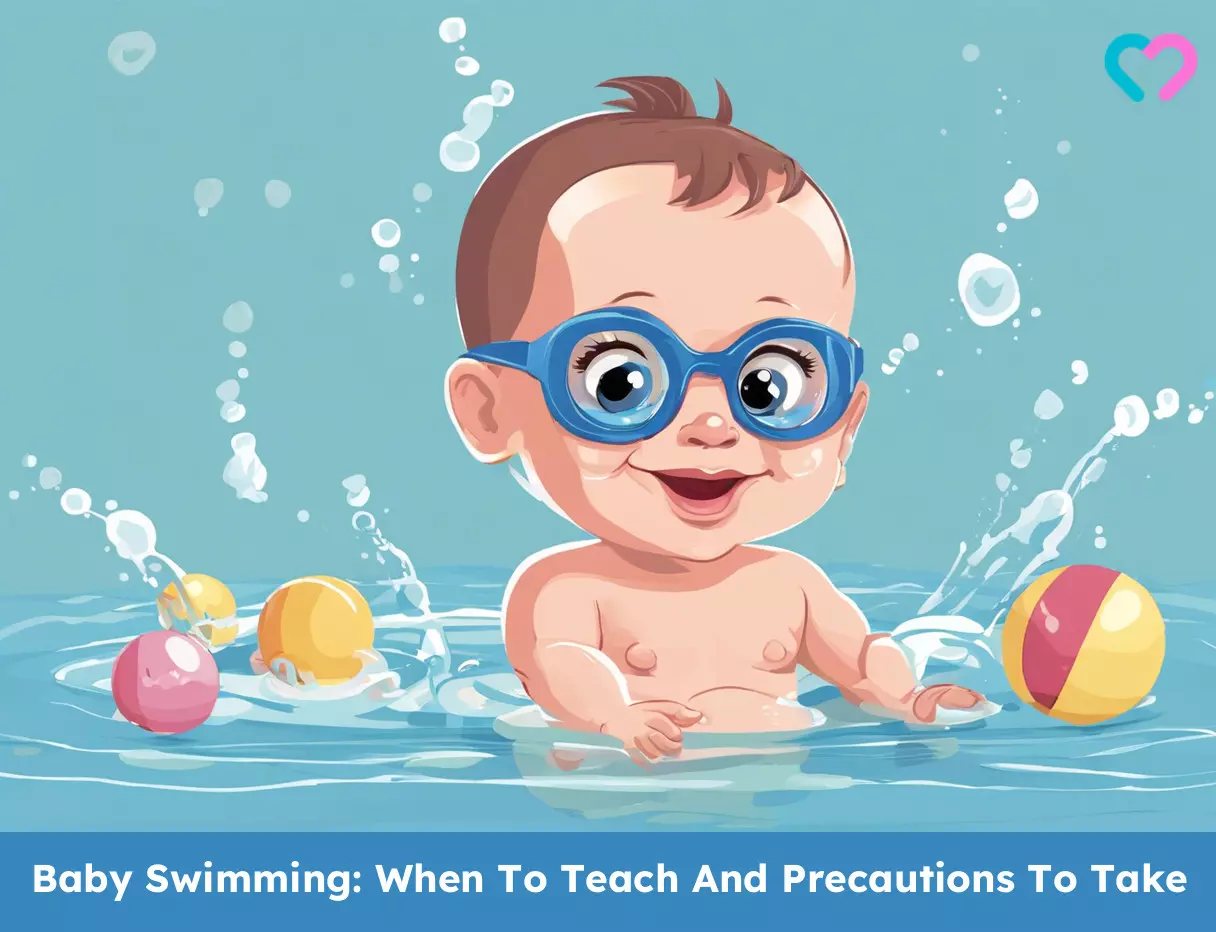
Image: Stable Diffusion/MomJunction Design Team
References
- Babies and swimming.
https://www.pregnancybirthbaby.org.au/babies-and-swimming - Devon Godek et al.; (2022); Physiology Diving Reflex.
https://www.ncbi.nlm.nih.gov/books/NBK538245/ - Swim Lessons: When to Start & What Parents Should Know.
https://www.healthychildren.org/English/safety-prevention/at-play/Pages/Swim-Lessons.aspx - Benefits of Water Play for Children.
https://pathways.org/splish-splash-the-benefits-of-water-play-for-children/ - 6 essential things you should know about swim lessons.
https://blog.cstx.gov/2021/04/22/6-essential-things-you-should-know-about-swim-lessons/ - Federica Borioni et al.; (2022); Effects of Baby Swimming on Motor and Cognitive Development: A Pilot Trial.
https://pubmed.ncbi.nlm.nih.gov/35473471/ - Kansas City-area infant swim lessons can help youngsters with cognitive development.
https://news.childrensmercy.org/kansas-city-area-infant-swim-lessons-can-help-youngsters-with-cognitive-development/ - Swim Lessons: When to Start & What Parents Should Know.
https://www.healthychildren.org/English/safety-prevention/at-play/Pages/Swim-Lessons.aspx - Voisin et al.; (2010); Infant swimming in chlorinated pools and the risks of bronchiolitis asthma and allergy.
https://pubmed.ncbi.nlm.nih.gov/20075053/
Community Experiences
Join the conversation and become a part of our nurturing community! Share your stories, experiences, and insights to connect with fellow parents.
Read full bio of Lenny Krayzelburg
Read full bio of Sanjana Bhattacharjee
Read full bio of Rohit Garoo
Read full bio of Ghazia Shah









